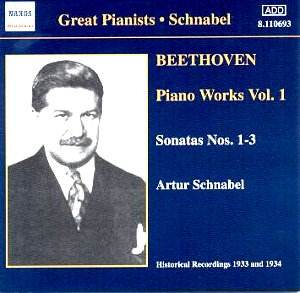Reputation can hang by a knife-edge. How would things
stand with Schnabel’s Beethoven had Rachmaninov accepted HMV’s earlier
offer to record the Sonatas? The Russian’s Beethoven would have been
of an entirely different character – digitally far more accurate and
undoubtedly avoiding Schnabel’s impulse toward extremes of tempo. Schnabel’s
Beethoven on record would have been confined to post-War and off-air
recordings, assuming that HMV had offered the Concertos to Rachmaninov
as well. That the loss of his Beethoven is one of the more grievous
in recording history – he wanted too much money – nevertheless opened
the door to another kind of now-canonical Beethoven interpretation,
that of Artur Schnabel (is there really much correlation between those
three successive titans of the twentieth century Germanic Beethoven
school – the Scot Lamond in the twenties, Schnabel in the thirties and
Schnabel’s anointed successor, Kempff, in the early fifties?).
But here once again are the "32" in this
new series from Naxos (in recent years we have had the cycle on EMI,
Nuova Era and Pearl). Schnabel was notoriously nervous of the recording
studios and the stories of his temperament are legion and yet awe is
often not too strong a word for many of the performances he enshrined
on disc, no matter how much that awe may on occasion be tempered by
dissent. The Naxos series starts at the beginning, with the Op 2 sonatas.
The F minor opens at quite a brittle and quick tempo, the Adagio – one
long six-minute take by the way – is correspondingly slow, its galant
Haydnesque style infused by Schnabelian intensity (and also serving
notice of tempo extremes to come). The Minuet is deliberate and solemn
whereas the finale is rhapsodic and quite fluent and fleet. The A major
follows – not a uniformly successful performance. There are some accelerandos
here that don’t quite convince in the opening movement, and Schanbel’s
fingers aren’t all there, the whole movement mysteriously hanging fire
in a gruffly ungenerous way. The Largo appassionato is taken at a deliberate
tempo, the "pizzicatos" of the left hand (Kempff’s word) animating
the arching melody above. The Scherzo is full of magical silences and
high spirits and Schnabel certainly spurns the more Grazioso aspects
of mid period Kempff in the finale, preferring instead fleetness of
finger. In the most expressive and obviously greatest of the trio of
Op 2, the C major, Schnabel opens the Allegro con brio in powerful style;
this whole movement suits his mobility of mind and finger, the sometimes
viscerally contrastive quality he brings to Beethoven, early, middle
and late. In the Adagio he exemplifies another aspect of his indisputable
greatness, which is not simply the extended tempo, but the proper maintenance
of that tempo. The Adagio is relatively slow but it breathes, has depth,
internal motion; it is, in a word, consequential. Similarly the Scherzo
is fuelled by drama, fully engaged by Schnabel and the splendidly phrased
finale has radiant life and affirmatory spirit – as well as Beethovenian
and Schnabelian cragginess it’s true, that adduce still more meaning
to the text.
In view of the price differential between the various
issues of Schnabel’s Beethoven Sonatas this Naxos entrant is a welcome
addition. At superbudget price it will be mandatory listening for those
yet to hear the Beethoven Society recordings in all their profound and
spiritual depth.
Jonathan Woolf

